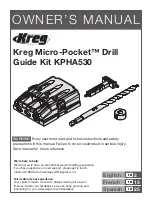
| English
10
IMPROPER USE
The machine must not be used for machining
hazardous materials, e.g. accumulation of inflam
-
mable or explosive products and any other object
that could be dangerous to the machine itself as
well as the operator, bystanders, animals or prop
-
erty.
Other examples of improper use may include, but
are not limited, to operation of the machine:
f
Without the original accessories supplied by the
manufacturer.
f
With original accessories but in a way not in accor-
dance to the instructions.
f
Without original spare parts.
f
With unauthorized modifications.
NOTE
According to the applicable product liability laws,
the manufacturer of the device does not assume lia
-
bility for damages to the product or damages caused
by the product that occurs due to:
f
Improper handling no complied with the operat
-
ing instructions.
f
Repairs by third parties and not by authorized ser
-
vice technicians.
f
Installation of non-original spare parts.
f
Non-intended use.
f
Electrical system breakdown due to power of the
machine in a manner not compliant with the elec
-
tric and VDE regulations.
TECHNICAL DATA
Article number
46 740
Model
ROS 150 BL PRO
Rated voltage
V
230-240
Rated frequency
Hz
50
Rated power
W
350
Rated no load speed
min
-1
4.000-10.000
Pad size
mm
150
Degree of protection
II
Net weight
kg
1,2
Sound emission values determined according to
EN 62841-1, EN 62841-2-4
Typically the A-weighted noise levels of the product are:
Sound pressure level (LpA)
dB(A)
79,7
Sound power level (LwA)
dB(A)
90,3
Uncertainty (K)
dB
3,0
Vibration total values ah (triax vector sum) and
uncertainty K determined according to
EN 62841-1, EN 62841-2-4
Vibration level max:
Vibration level (a
h, HD
)
m/s
2
3,2
Uncertainty (K)
m/s
2
1,5
IDENTIFICATION (FIG. 1)
1. Operating speed button (increase)
2.
Operating switch
3.
Power cable
4. Operating speed button (decrease)
5.
Dust extractor connector
6.
Dust extractor LED light
7.
Sanding pad
8. Operation lever
OPERATION
PREPARING THE UNIT
Unpacking and completing the assembly should
be done on a flat and stable surface, with enough
space for moving the machine and its packaging,
always making use of suitable equipment.
NOTE
The installed electric motor is completely wired and
ready for operation. The customer‘s connection to
the power supply sys¬tem, and any extension cables
that may be used, must conform with local regula
-
tions. Check electrical connection cables regularly
for damage. Make sure the cable is disconnected
from the mains when checking. Electrical connection
cables must comply with the regulations applicable
in your country.
f
The mains voltage must coincide with the voltage
specified on the motor’s rating plate.
f
Dimension cables up to a length of 25m must have
a cross-section of 1.5mm
2
and beyond 25m at least
2.5mm
2
.
f
The connection to the mains must be protected
with an appropriate slow acting fuse.
WARNING
Connect the machine only to a socket with the prop
-
erly installed ground contact.
Tool attachment (Fig. 4)
The suitable sand paper and sanding cloth can be
attached quickly and simply to the sanding pad
(Fig. 1.7), by pressing the self-adhesive sanding
accessory onto the sanding pad.
WARNING
If the adhesive strength of the sanding pad surface
weakens, the sanding accessory may come loose
from the sanding pad and become a source of dan
-
ger. In this case, stop the operation of the machine
and replace the sanding pad immediately.
Choosing the right size, grit and type of sandpa
-
per maximizes the quality of your sanded finish.
Aluminum oxide, silicon carbide, and other syn
-
thetic abrasives are best for power sanding as
natural abrasives, such as flint and garnet, are
too soft for economical use in power sanding. In
general, coarse grit will remove the most materi
-
al and finer grit will produce the best finish in all
sanding operations. The condition of the surface
to be sanded will determine the right grit for the
job. If the surface is rough, start with a coarse grit
and sand until the surface is uniform. Medium grit
may then be used to remove the scratches left by
the coarser grit while a finer grit can be used for
finishing. Always continue sanding with next grit
until surface is uniform.
ROS 150 BL PRO
Содержание ROS 150 BL PRO
Страница 3: ...www ffgroup tools com 3 3 4 5 ROS 150 BL PRO...
Страница 24: ...24 f f f f f f 1 5mm2 ROS 150 BL PRO...
Страница 25: ...www ffgroup tools com 25 1 2 3 4 f f f f ROS 150 BL PRO...
Страница 28: ...28 3 4 5 1 2 3 ROS 150 BL PRO...











































